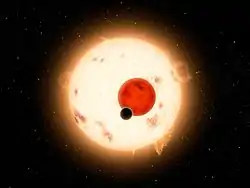Kepler-16
Kepler-16 is an eclipsing binary star system in the constellation of Cygnus[7] that was targeted by the Kepler spacecraft. Both stars are smaller than the Sun; the primary, Kepler-16A, is a K-type main-sequence star and the secondary, Kepler-16B, is an M-type red dwarf. They are separated by 0.22 AU, and complete an orbit around a common center of mass every 41 days.
_system.png.webp)
The Kepler-16 system.
 An artist's rendering of the Kepler-16 system, showing the binary star being orbited by Kepler-16b. Credit: NASA/JPL-Caltech | |
| Observation data Epoch J2000 Equinox J2000 | |
|---|---|
| Constellation | Cygnus |
| Right ascension | 19h 16m 18.1759s[1] |
| Declination | +51° 45′ 26.778″[1] |
| Characteristics | |
| Spectral type | K / M[2] |
| Astrometry | |
| Proper motion (μ) | RA: 14.041±0.054[1] mas/yr Dec.: −48.601±0.051[1] mas/yr |
| Parallax (π) | 13.2893 ± 0.0271[1] mas |
| Distance | 245.4 ± 0.5 ly (75.2 ± 0.2 pc) |
| Orbit[3] | |
| Primary | Kepler-16A |
| Companion | Kepler-16B |
| Period (P) | 41.079220 (± 0.000078) d |
| Semi-major axis (a) | 0.22431 (± 0.00035) AU |
| Eccentricity (e) | 0.15944 (± 0.00062) |
| Inclination (i) | 90.30401 (± 0.0019)° |
| Longitude of the node (Ω) | 0° |
| Periastron epoch (T) | BJD 2455212.12316 |
| Argument of periastron (ω) (secondary) | 263.464 (± 0.027)° |
| Details | |
| Kepler-16A | |
| Mass | 0.6897 (± 0.0035) M☉ |
| Radius | 0.6489 (± 0.0013) R☉ |
| Luminosity | 0.148[4] L☉ |
| Surface gravity (log g) | 4.6527 (± 0.0017) cgs |
| Temperature | 4450 (± 150) K |
| Metallicity [Fe/H] | -0.3 (± 0.2) dex |
| Rotation | 35.1 ± 1.0 days[5] |
| Kepler-16B | |
| Mass | 0.20255 (± 0.00065) M☉ |
| Radius | 0.22623 (± 0.00059) R☉ |
| Luminosity | ~0.0057[4] L☉ |
| Surface gravity (log g) | 5.0358 (± 0.0017) cgs |
| Temperature | ~3311[4] K |
| Other designations | |
| Database references | |
| SIMBAD | data |
| KIC | data |
The system is host to one known extrasolar planet in circumbinary orbit: the Saturn-sized Kepler-16b.
Planetary system
Kepler-16b is a gas giant that orbits the two stars in the Kepler-16 system.[3] The planet is a third of Jupiter's mass and slightly smaller than Saturn at 0.7538 Jupiter radii, but is more dense. Kepler-16b completes a nearly circular orbit every 228.776 days.
| Companion (in order from star) |
Mass | Semimajor axis (AU) |
Orbital period (days) |
Eccentricity | Inclination | Radius |
|---|---|---|---|---|---|---|
| b | 0.333 MJ | 0.7048 | 228.776 | 0.0069 | 90.032° | 0.7538 RJ |
References
- Brown, A. G. A.; et al. (Gaia collaboration) (August 2018). "Gaia Data Release 2: Summary of the contents and survey properties". Astronomy & Astrophysics. 616. A1. arXiv:1804.09365. Bibcode:2018A&A...616A...1G. doi:10.1051/0004-6361/201833051. Gaia Data Release 2 catalog entry
- Jean Schneider (2011). "Notes for star Kepler-16 (AB)". Extrasolar Planets Encyclopaedia. Retrieved 23 September 2011.
- Doyle, Laurance R.; Carter, Joshua A.; Fabrycky, Daniel C.; Slawson, Robert W.; Howell, Steve B.; Winn, Joshua N.; Orosz, Jerome A.; Prša, Andrej; Welsh, William F.; et al. (2011). "Kepler-16: A Transiting Circumbinary Planet". Science. 333 (6049): 1602–6. arXiv:1109.3432. Bibcode:2011Sci...333.1602D. doi:10.1126/science.1210923. PMID 21921192. S2CID 206536332.
- Haghighipour, Nader; Kaltenegger, Lisa (24 October 2013). "Calculating the Habitable Zone of Binary Star Systems. II. P-type Binaries". The Astrophysical Journal. 777 (2): 13. arXiv:1306.2890. Bibcode:2013ApJ...777..166H. doi:10.1088/0004-637X/777/2/166. S2CID 118494204.
- Winn, Joshua N.; et al. (2011). "Spin-Orbit Alignment for the Circumbinary Planet Host Kepler-16 A". The Astrophysical Journal Letters. 741 (1). L1. arXiv:1109.3198. Bibcode:2011ApJ...741L...1W. doi:10.1088/2041-8205/741/1/L1.
- "Kepler-16". SIMBAD. Centre de données astronomiques de Strasbourg. Retrieved 2020-08-09.
- Drake, Nadia. "On Kepler-16b, shadows come in pairs". Science News. Society for Science & the Public. Archived from the original on 28 August 2012. Retrieved 16 September 2011.
- Jean Schneider (2011). "Notes for Planet Kepler-16 (AB) b". Extrasolar Planets Encyclopaedia. Archived from the original on 11 October 2011. Retrieved 23 September 2011.
This article is issued from Wikipedia. The text is licensed under Creative Commons - Attribution - Sharealike. Additional terms may apply for the media files.